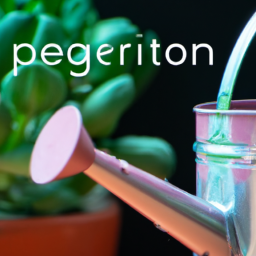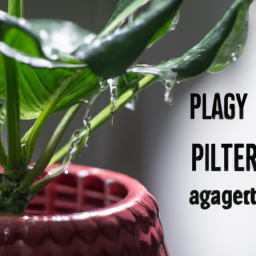
Hey there plant enthusiasts! Welcome to our blog post on Hydration 101: Best Practices for Watering Your Plants. Whether you’re a seasoned green thumb or just starting your plant parent journey, one thing remains constant – hydration is key! Just like humans, plants need water to survive and thrive. But how much water is enough? How often should you water your plants? Don’t worry, we’ve got you covered. In this post, we’ll dive into the best practices for watering your plants, ensuring they receive the perfect amount of hydration to keep them happy and healthy. So, grab your watering cans and let’s get started!
The Importance of Proper Hydration for Plants
When it comes to taking care of your plants, one of the most crucial aspects is ensuring they receive the proper hydration. Just like humans, plants require water to survive and thrive. Water plays a vital role in the growth and development of plants, as it is involved in various physiological processes. In this article, we will explore the importance of proper hydration for plants and provide you with best practices for watering your beloved green friends.
Understanding the Role of Water in Plant Life
Water is an essential component for plants as it serves several critical functions. Firstly, it acts as a solvent, allowing plants to absorb and transport nutrients from the soil to different parts of the plant. Additionally, water helps in the process of photosynthesis, where plants convert sunlight into energy. Without adequate hydration, plants cannot carry out this vital process effectively.
Furthermore, water is responsible for maintaining the turgidity of plant cells. Turgid cells help plants maintain their structure and rigidity, allowing them to stand upright and support their leaves and flowers. Insufficient water supply can lead to wilting and eventually, the death of the plant.
Water also plays a significant role in regulating plant temperature. Through a process known as transpiration, plants release moisture from their leaves, which cools down the plant and the surrounding environment. This cooling effect is particularly crucial during hot summer days when plants are at risk of overheating.
Signs of Dehydration in Plants
Just like humans, plants exhibit signs of dehydration when they lack sufficient water. It’s essential to be able to recognize these signs to address the issue promptly. Some common signs of dehydration in plants include:
1. Wilting: When a plant lacks water, it will start to wilt. The leaves and stems become droopy and lose their rigidity. This is a clear indication that the plant needs water.
2. Dry Soil: If the soil around your plant feels dry to the touch, it’s a sign that the plant is not receiving enough water. Dry soil can prevent the roots from absorbing the necessary moisture.
3. Yellowing Leaves: When a plant is dehydrated, its leaves may start to turn yellow. This can be a result of nutrient deficiencies caused by impaired water uptake.
4. Stunted Growth: Insufficient water supply can hinder a plant’s growth. If your plant is not growing as expected or its growth has slowed down significantly, it may be a sign of dehydration.
Best Practices for Watering Your Plants
Now that you understand the importance of proper hydration for plants and how to recognize signs of dehydration, let’s delve into some best practices for watering your plants:
1. Watering Frequency: The frequency of watering depends on various factors such as plant type, weather conditions, and soil type. In general, it’s better to water deeply and less frequently rather than shallowly and frequently. This encourages deep root growth and helps plants become more resilient to drought conditions.
2. Time of Day: It’s best to water your plants early in the morning or late in the evening when temperatures are cooler. This allows the plants to absorb water without the risk of excessive evaporation. Avoid watering during the hottest part of the day to prevent scorching the leaves.
3. Watering Techniques: When watering your plants, aim to water the soil directly at the base of the plant rather than the leaves. This ensures that the water reaches the roots where it is needed the most. Use a watering can or a drip irrigation system for precise and efficient watering.
4. Drainage: Adequate drainage is crucial for plant health. Ensure that your pots or garden beds have proper drainage holes to prevent waterlogging. Excess water can lead to root rot and other fungal diseases.
5. Mulching: Apply a layer of organic mulch around your plants to help retain moisture in the soil. Mulch acts as a barrier, reducing evaporation and keeping the soil cool. It also helps suppress weed growth, which can compete with your plants for water and nutrients.
6. Monitor and Adjust: Pay attention to your plants’ individual needs and adjust your watering routine accordingly. Factors like temperature, humidity, and rainfall can affect the water requirements of your plants. Regularly check the moisture level of the soil to ensure it is neither too dry nor too waterlogged.
By following these best practices, you can ensure that your plants receive the proper hydration they need to thrive. Remember, each plant is unique, so it’s essential to observe and understand the specific requirements of your plants to provide them with the best care possible.

Hydration 101: Best Practices for Watering Your Plants
2. Watering Techniques for Different Types of Plants
When it comes to watering your plants, it’s important to understand that different types of plants have different watering needs. While some plants thrive in moist conditions, others prefer drier soil. In this section, we will explore various watering techniques for different types of plants.
2.1. Succulents and Cacti
Succulents and cacti are known for their ability to store water in their leaves and stems, making them highly adapted to dry environments. When watering succulents and cacti, it’s crucial to avoid overwatering, as excessive moisture can lead to root rot and other issues.
One effective technique for watering succulents and cacti is the “soak and dry” method. This involves thoroughly watering the plant until water drains out of the bottom of the pot. Allow the soil to dry completely before watering again. This method mimics the natural rainfall patterns in arid regions, providing the plants with the necessary moisture without causing waterlogged conditions.
Another important aspect to consider when watering succulents and cacti is the type of soil used. Well-draining soil, such as a mix of cactus potting soil and perlite, is essential to prevent water from sitting around the roots for too long.
2.2. Leafy Greens and Herbs
Leafy greens and herbs, such as lettuce, spinach, and basil, require a consistent supply of moisture to thrive. These plants have shallow roots and can quickly wilt if not watered adequately. However, it’s crucial to strike a balance and avoid overwatering, as it can lead to root diseases.
One effective technique for watering leafy greens and herbs is the “daily misting” method. This involves lightly misting the plants’ leaves with water once or twice a day, especially during hot and dry periods. Additionally, it’s important to provide a regular water supply to the soil, ensuring it remains consistently moist but not waterlogged.
Using a well-draining soil mix enriched with organic matter can help retain moisture while allowing excess water to drain away. Regularly monitoring the soil moisture levels by inserting your finger into the soil can also help determine when it’s time to water.
2.3. Flowering Plants
Flowering plants, such as roses, lilies, and petunias, require a careful balance of water to promote healthy growth and abundant blooms. Overwatering can lead to root rot and fungal diseases, while underwatering can cause stunted growth and wilting.
One effective technique for watering flowering plants is the “root zone watering” method. This involves directing the water directly to the root zone, allowing it to penetrate deeply into the soil. Avoid overhead watering, as it can lead to wet foliage and increase the risk of diseases.
It’s important to water flowering plants deeply but infrequently. This encourages the roots to grow deeper into the soil, making the plants more resilient to drought conditions. Applying a layer of organic mulch around the base of the plants can help retain moisture and regulate soil temperature.
Regularly monitoring the moisture levels in the soil and adjusting the watering frequency based on the weather conditions and plant’s needs is essential for maintaining healthy flowering plants.
Conclusion
Watering your plants properly is crucial for their overall health and growth. By understanding the specific watering needs of different types of plants, you can ensure they receive the right amount of moisture without causing any harm. Remember to consider factors like the plant’s natural habitat, soil type, and weather conditions when determining the best watering techniques. With proper hydration, your plants will thrive and reward you with lush foliage, vibrant blooms, and bountiful harvests.

3. Common Mistakes to Avoid When Watering Your Plants
Watering your plants may seem like a simple task, but there are some common mistakes that many people make. These mistakes can have a negative impact on the health and growth of your plants. In this article, we will discuss three common mistakes to avoid when watering your plants, and provide you with the best practices to ensure your plants thrive.
Overwatering
One of the most common mistakes gardeners make is overwatering their plants. It’s easy to think that more water is better, but this is not the case. Overwatering can lead to root rot, which can ultimately kill your plants. Additionally, overwatering can wash away essential nutrients from the soil, leaving your plants malnourished.
To avoid overwatering, it’s important to understand the water needs of your specific plants. Different plants have different water requirements, so it’s essential to do your research. Generally, plants should be watered when the top inch of soil feels dry. Use your finger to check the moisture level, and only water if it feels dry. Remember, it’s better to underwater than overwater.
Another helpful tip to prevent overwatering is to use well-draining soil. If your soil retains water for too long, it can lead to waterlogged roots. Adding organic matter, such as compost, can improve the drainage of your soil. Additionally, using pots with drainage holes can help excess water escape.
Underwatering
While overwatering is a common mistake, underwatering is equally detrimental to your plants. When plants don’t receive enough water, they can become dehydrated and wilt. This can stunt their growth and make them more susceptible to pests and diseases.
One way to avoid underwatering is to establish a regular watering schedule. Consistency is key when it comes to watering your plants. Depending on the type of plant, you may need to water daily, every few days, or weekly. Research the specific water requirements of your plants and create a schedule that works for them.
It’s also important to water deeply when you do water your plants. Shallow watering can encourage shallow root growth, which makes plants more vulnerable to drought. Instead, water until the soil is thoroughly saturated, allowing the water to reach the deeper roots. This will promote healthy root development and overall plant growth.
Improper Timing
The timing of watering your plants is crucial for their well-being. Watering during the hottest part of the day can cause the water to evaporate quickly, leaving your plants thirsty. It’s best to water in the early morning or late afternoon when the temperature is cooler, and the sun is not as intense. This allows the water to penetrate the soil and be absorbed by the roots before evaporating.
Another aspect of timing to consider is watering frequency. Watering too frequently can prevent the roots from developing deep into the soil in search of water. This can result in weak and shallow root systems. On the other hand, watering too infrequently can stress the plants and hinder their growth. Finding the right balance is essential.
Observing your plants is key to determining the correct timing for watering. Look for signs of dehydration, such as wilting leaves or dry soil, and adjust your watering schedule accordingly. Remember that different plants have different water needs, so it’s important to pay attention to their individual requirements.
Avoiding these common mistakes and following the best practices for watering your plants will help ensure their health and vitality. Remember to research the specific water requirements of your plants, establish a regular watering schedule, and pay attention to the timing of your watering. By doing so, you’ll be well on your way to becoming a successful plant parent!
In a Nutshell
Watering your plants may seem like a simple task, but there is actually a science to it. Proper hydration is essential for the health and growth of your plants, and understanding the best practices can make a significant difference in their overall well-being. So, let’s dive into Hydration 101 and learn some valuable tips for watering your beloved greenery.
First and foremost, it’s crucial to understand that different plants have different water requirements. Factors such as the type of plant, its size, and the environment it’s in can all influence how much water it needs. Generally, most plants prefer a consistent watering schedule rather than sporadic drenching. It’s best to water them deeply but infrequently, allowing the soil to dry out slightly between watering sessions. This encourages the plants to develop strong and deep root systems, making them more resilient to drought conditions. Additionally, it’s important to water the soil directly rather than the leaves, as wet foliage can lead to fungal diseases. Using a watering can or a soaker hose can help ensure that the water reaches the roots where it’s needed the most.
Another vital aspect to consider is the time of day you choose to water your plants. Early morning is generally the best time, as it allows the plants to absorb the water before the heat of the day evaporates it. Watering in the evening is not recommended, as the prolonged moisture on the leaves overnight can promote the growth of mildew and other harmful pathogens. However, if mornings are not feasible, aim for late afternoon, giving the plants enough time to dry before nightfall. Remember, consistency is key, so try to establish a regular watering routine that suits both you and your plants.
By following these simple guidelines, you can become a pro at watering your plants and ensure their optimal health and growth. Remember to pay attention to the specific needs of each plant, water deeply but infrequently, and choose the right time of day to water. With a little practice, you’ll be rewarded with lush and thriving greenery that will brighten up your space for years to come.
Frequently Asked Questions (FAQ):
Q1: How often should I water my plants?
A1: The frequency of watering your plants depends on several factors such as the type of plant, the weather conditions, and the soil moisture level. As a general rule, most plants thrive with a regular watering schedule of once or twice a week. However, it’s essential to monitor the moisture level of the soil and adjust accordingly. Stick your finger about an inch into the soil, and if it feels dry, it’s time to water.
Q2: What is the best time of day to water plants?
A2: The best time to water your plants is in the early morning, preferably before the sun gets too intense. Watering in the morning allows the plants to absorb moisture and nutrients throughout the day, promoting healthy growth. Avoid watering in the evening or at night as it can lead to prolonged moisture on the foliage, increasing the risk of fungal diseases.
Q3: How much water should I give my plants?
A3: The amount of water your plants need depends on various factors like plant type, size, and environmental conditions. As a general guideline, aim to provide a thorough watering until the top few inches of soil are moist. However, be cautious not to overwater, as it can lead to root rot and other issues. It’s better to water deeply and less frequently, allowing the roots to grow deeper and become more resilient.
Q4: Can I use tap water to hydrate my plants?
A4: In most cases, tap water is perfectly suitable for watering plants. However, some plants may be sensitive to the chemicals present in tap water, such as chlorine or fluoride. If you notice any adverse effects like leaf discoloration or stunted growth, consider using filtered water or letting tap water sit out for 24 hours to allow the chlorine to dissipate before using it on your plants.
Q5: Are there any signs that indicate my plants need more water?
A5: Yes, there are several signs that indicate your plants need more water. Wilting leaves, dry or cracked soil, and yellowing or browning of the edges of the leaves are common signs of dehydration. Additionally, some plants may have specific indicators like drooping or soft stems. Regularly inspect your plants and be attentive to their needs to ensure they receive adequate hydration.

James Wong is a renowned ethnobotanist, plant scientist, and local television presenter. With a passion for demystifying plant science, he is known for translating complex botanical concepts into practical advice for everyday plant enthusiasts. James’s expertise spans from traditional gardening to cutting-edge plant technologies, making his insights accessible and informative.


